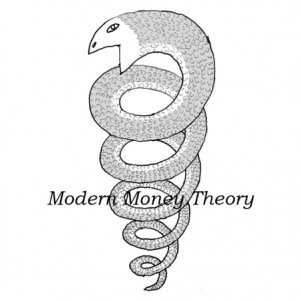By J.D. ALT
The theme and illustrations of this essay are from the new book “Paying Ourselves to Save the Planet.”
It might seem, as we observe the U.S. government “instantly” generating $2 trillion new dollars for direct payments and grants to people and businesses, that the coronavirus pandemic has shed a new light on the authenticity (and necessity) of modern money theory (MMT). But that light, if it is being shed at all, is illuminating instead the dramatic limitations of the “standard money theory” we insist on applying to the exigencies of an unfolding modern society (including, but not limited to, how to deal with pandemics).
What do I mean by “standard money theory”? I mean a very simple assumption implicitly built into our mental models of how money works: namely, that the only money available to sovereign governments for their spending purposes are dollars (or euros, or yen etc.) that have been earned in private enterprise. According to the standard theory, the government (in order to spend) must claim a share of that privately earned money through taxation—and if that is not adequate to meet its spending needs, it must borrow a further share by issuing treasury bonds (government debt) which, themselves, can only be redeemed by the collection of future taxes on private earnings. Thus, government spending to buy the goods and services of public enterprise—those things which profit-seeking private enterprise is unwilling or unable to provide but which collective society requires for its vital functioning—that government spending is literally “feeding” on the fruits of personal labor and entrepreneurship. This view of the sovereign government as the Ouroboros—the mythical snake eating its own tail—permeates our mental models and government policies about money, taxes, and “private” versus “public” enterprise. The snake can eat only so much of its tail before the unimaginable happens!

This perspective leads inexorably and inescapably to two overarching positions in the national economic and fiscal policy debate: First, the snake must be given free rein and nourishment to grow (to stay ahead of the consuming mouth of public enterprise);second, public enterprise’s voracious mouth must be forcefully held in check, lest it get ahead of the snake’s growth, and gobble itself toward the unimaginable oblivion. The tension between these positions has become paralyzing in today’s modern society—as is now evident in our confrontation with the coronavirus. (It will become more evident—and more tense—as the global climate crises unfolds.)
A case in point is a recent news article in the Washington Post about the efforts, within the last decade, by the federal government (spurred by the SARS epidemic) to establish a national preparedness for the next pandemic. A study group identified one of the weakest links to be the availability of protective respirator masks for medical personnel. These masks, unlike other medical components, cannot be produced ahead of time and stock-piled because they have a relatively short shelf-life, with no way of predicting how many years they’d have to sit on their shelves before a pandemic arrived. The federal government awarded a $5M contract to a private medical company to design a high-speed machine that could manufacture the protective masks—as needed—after a pandemic occurred. The design was completed and submitted to the government in 2018—along with a request for the next stage of funding for the more expensive task of building and testing a prototype. This, apparently, was one “bite” too far to allow the Ouroboros: The project was abandoned by the Trump administration— (the same year, it should be noted, that the Ouroboros was fed a gargantuan, growth-seeking meal of tax-cuts).
In hindsight it was obviously a bad decision—but a decision that even political progressives, strapped with the perspective of the Ouroboros, are virtually helpless to counteract. Even president Obama admitted the government was “broke,” and spent a lot of golfing hours with John Boehner negotiating a “grand bargain” to restrain the snake’s out-of-control appetite.
But it was only one of many relevant bad decisions driven and informed by the standard money theory. We read about the 1980’s when, during the SARS epidemic, big-pharma saw great potential for profit-making in the development of a vaccine—and made significant strides in developing one, only to abandon the effort (just closing in on the brink of achievement!) when the SARS virus suddenly subsided: The “market” disappeared!—so what purpose (from the perspective of a profit-oriented and profit financed business) was there in continuing with the effort? It’s now clear that vaccine, had the final efforts been made to develop and test it, could well have proved fateful against the coronavirus we now confront. So, great “profit” could have resulted, but not in the kind of “profit timeline” that profit-demanding private enterprise requires.
So now private enterprise starts again from scratch. Are its fingers crossed that, this time, the pandemic will last long enough to provide a profit-making “market”? Or has another reality taken hold? The realization that without the health and prosperity of collective society private enterprise itself is threatened? Does the Ouroboros now need to be given bigger, trillion dollar tax bites?
What needs to be made clear—shouted from the media rooftops—is that another perspective of the Ouroboros is possible—a perspective in which the tensions of self-consumption disappear, and public enterprise is freed to pursue what is necessary for collective society to meet its challenges and prosper. This other perspective, of course, is modern money theory, or MMT.
MMT views the same phenomena—the collection of taxes by the sovereign government, the issuance of treasury bonds—but sees a completely different structure than what the standard theory insists upon. MMT sees that taxes are spent for public enterprise—but the purpose of taxes is not to fund public enterprise. The purpose of taxes is to infuse the sovereign fiat money with authoritative value. MMT sees that treasury bonds are issued when taxes fall short of the spending needs of public enterprise—but the act of issuing treasury bonds is not the act of “borrowing” money from the private earnings of people and businesses. It is, instead, the act of issuing new sovereign fiat money which subsequently lands in the spending account of public enterprise.
“Deficit spending” is merely an accounting calculation of the difference between taxes collected and treasury bonds issued. What the standard theory so ominously refers to as the “national debt” is not something that ever has to be repaid to anybody for the simple reason that they’ve already been paid (with the treasury bonds themselves which can be exchanged/traded at any moment of the day for sovereign fiat money).
From the perspective of MMT, then, the Ouroboros appears as a completely different animal!

The snake is not eating its tail at all! One might ask what, then, is the snake feeding on if it’s not taxes and private earnings? The answer is it is feeding on the real resources—labor, inventiveness, and materiel—which are available to be put to work in the pursuit of public enterprise. Its feeding has nothing to do with the availability of money but rather the opposite: the availability of money matches the availability of the real resources which public enterprise can marshal to accomplish its goals.
Which brings us, of course, full circle back to what we should be seeing and understanding in the federal government’s response to the pandemic: We are not talking about (and shouldn’t be fretting about) collecting $2.2 trillion in new taxes—now, or ever. Just as we won’t be talking about collecting $100 trillion in new taxes when we get serious about confronting the climate crisis. What we’re talking about, instead, is employing trillions of dollars’ worth of real resources—labor, inventiveness, and materiel—to accomplish the things that private enterprise and finance cannot find a profit in doing, but which need to be done, nevertheless.












29 responses to “Standard Money Theory and the Coronavirus”